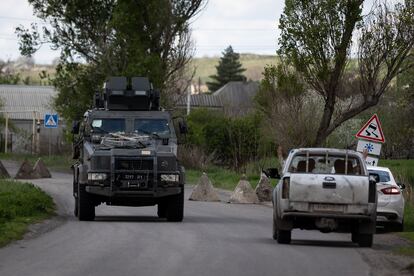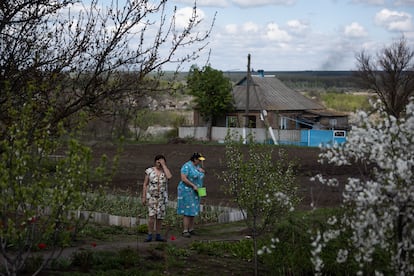Bloody, exhausting and drawn-out: How the key battle in Donbas will play out
Russian forces are seeking to encircle Ukrainian troops in the east in a fight that is expected to become a determining phase in the war


Maybe it was a neighbor who snitched on him. Or a Russian spy. In any event, a huge explosion set fire to Yuri’s pens, killing 20 cows, blowing away the corrugated iron roof and carving a huge hole in the floor of the farm, located in the middle of nowhere in Ukraine’s eastern Donetsk region. The property lies between plowed fields and dirt roads on the increasingly active Izyum front, where fighting between Ukrainian and Russian forces has intensified in recent days. The Russian strike targeted Ukrainian positions, but soldiers from Kyiv often rely on mobile outposts, and the Russians missed the mark. “Someone probably reported that there were Ukrainian soldiers in the area, but they missed. And they will miss again,” remarks a Ukrainian army officer.
The roar of the strikes on Ukraine’s eastern front is relentless, plumes of smoke staining the blue spring sky in this rural region. The Kremlin’s troops are advancing from the occupied city of Izyum in order to encircle Ukrainian defenders and conquer the entire Donbas area. These are signs that the second phase of the invasion of Ukraine launched by Russian President Vladimir Putin on February 24 is already underway. A war that was launched under the false rhetoric of “de-Nazifying” a country led by a Jewish president and “liberating and protecting” Russian-speaking residents in the east who are now in fact being bombed by Russia.
Following the Kremlin’s failure to advance towards Kyiv and hold occupied areas in northeastern Ukraine, the scene of brutal Russian repression, Moscow has launched a new campaign with a more limited objective focused on capturing the Donbas and the south.
New strategy
The strategy now is different, military analysts point out. The soldiers sent by Putin have managed to bite off a crescent-shaped territory in the east and south of Ukraine. They now seek to advance from their positions in the northeast and south to encircle the Ukrainian troops, well positioned and entrenched in an already heavily militarized area that has been the scene of fighting for the last eight years, after pro-Russian separatists backed politically and militarily by Moscow declared the independence of the Donetsk and Lugansk regions.

Since then, the Kremlin – which recognized the independence of the two territories one day before launching the invasion – has controlled 30% of the Donbas area. And from those positions, it is also trying to push a 500-kilometer frontline that had remained largely stationary since 2014 and was strongly protected by the Ukrainian army, which had stationed at least a third of its soldiers in Donbas, including its most professional and hardened battalions.
The Russian advance is not fast but it is methodical, point out analysts from the Institute for the Study of War (ISW). The offensive is based on incursions by tactical battalions at different points, followed by the deployment of more soldiers to keep the Ukrainian defenders occupied in those positions. Russia has also used more intense attacks with mortars, shells, rocket launchers, as well as strikes from helicopters and low-flying planes, an official says. Kremlin forces have already seized a dozen small rural towns in the Donetsk and Lugansk regions.

In Prelesne, a bucolic village on the Izyum front, a few kilometers from the small town that is already in Russian hands, Valentina and Liudmila tend to their garden, apparently oblivious to the constant explosions and columns of black smoke on the horizon. Kind of like Valentina’s husband, Vitali, who barely flinches and smokes a cigarette as he watches the two women at work. “We are scared, but we are also hungry. We have to eat,” says Liudmila, who took in her son and daughter-in-law Valentina after the Kramatorsk factory where the couple worked closed down at the beginning of the war. Now, the bombs are getting closer, but everything has become part of the landscape, a reality that, as with the Donbas war that began in 2014, runs the risk of becoming entrenched and absorbing the life of the entire area.
Scorched earth in Izyum
As in other occupied towns, Russian forces have applied a scorched-earth policy in Izyum, says its mayor, Valeri Marchenko, who left the city of 46,000 inhabitants with a group of evacuees before the advance of Moscow soldiers. Earlier he had received a call from a Russian officer telling him to hand over the city. “Of course I refused,” Marchenko says over the phone from an undisclosed location, confessing that he did not want to leave Izyum. The government order, however, was clear, he explains: the Russian occupiers have already kidnapped more than 20 public servants, and Marchenko was on the list. Despite the fact that the town has poor communications, its neighbors have reported looting, beatings and forced deportations to Russia.
Izyum was the scene of fighting between Ukrainian and Russian forces for weeks, but Putin’s troops, backed by air support, managed to take the small town, where they quickly changed the name of John Lennon Square to Soviet Square. From Izyum they are now advancing towards the city of Sloviansk and towards Kramatorsk, the de facto capital of Donetsk province and the military seat of the Donbas, an area of some 52,000 square kilometers, roughly the size of Costa Rica.
The Kremlin has sent to the east most of the 190,000 troops that were mobilized to invade Ukraine. And after the lack of coordination at the beginning of the invasion, he has placed a single general – Alexander Dvornikov – at the command of what he calls a “special military operation,” instead of the several who led the failed offensives on various flanks. Furthermore, the area it now controls borders on its own territory, so Russia could benefit from a long battle without exposing its supply lines and with better communications and logistics.
Kyiv’s troops are also preparing for an assault. They have reinforced their positions along the Izyum front and are now laying out new fortifications. In addition, reinforcements from all over the country are arriving in the area. Also new weapons, fuel and supplies. The Ukrainian president, Volodymyr Zelenskiy, has asked the allied countries for new shipments of heavy weapons and anti-aircraft defense systems to face this new phase of the war, which for the Kremlin may have May 9 as a key date, when Russia is set to celebrate with great military parades the victory of the Red Army over Nazi Germany. By then, Putin must have something to sell back home as an achievement, such as the seizure of the port city of Mariupol in the southern Donetsk region.
Meanwhile, military analysts anticipate that the battle could be bloody, exhausting and drawn-out. It is also expected to determine the course of the entire war and to mark the evolution of post-war Ukraine.
In Sloviansk, where those who have remained behind line up at the few open shops and at ATMs, Viktor, a retired miner, sorts his shopping bags. “Some have stayed because they don’t care who is in charge, but many others are here because we believe in victory, even if it’s a late one,” he says. The city, where some scars of old attacks are mixed with newer ones, could be a fundamental stage in this war and the next battlefield.
Around the town, which was a key point in the 2014 war and was briefly under pro-Russian hands, military checkpoints are looking for informers and infiltrators; as elsewhere in Ukraine. And although Viktor points out that almost everyone in town knows more or less where everyone else stands, the residents are looking at each other out of the corner of their eyes: “War is not an unknown thing here. We have lived through it for eight years and every day it gets worse,” he says. “Hope is declining month after month, day after day, but I still maintain it.”
Tu suscripción se está usando en otro dispositivo
¿Quieres añadir otro usuario a tu suscripción?
Si continúas leyendo en este dispositivo, no se podrá leer en el otro.
FlechaTu suscripción se está usando en otro dispositivo y solo puedes acceder a EL PAÍS desde un dispositivo a la vez.
Si quieres compartir tu cuenta, cambia tu suscripción a la modalidad Premium, así podrás añadir otro usuario. Cada uno accederá con su propia cuenta de email, lo que os permitirá personalizar vuestra experiencia en EL PAÍS.
¿Tienes una suscripción de empresa? Accede aquí para contratar más cuentas.
En el caso de no saber quién está usando tu cuenta, te recomendamos cambiar tu contraseña aquí.
Si decides continuar compartiendo tu cuenta, este mensaje se mostrará en tu dispositivo y en el de la otra persona que está usando tu cuenta de forma indefinida, afectando a tu experiencia de lectura. Puedes consultar aquí los términos y condiciones de la suscripción digital.
More information
Últimas noticias
Most viewed
- Reinhard Genzel, Nobel laureate in physics: ‘One-minute videos will never give you the truth’
- Oona Chaplin: ‘I told James Cameron that I was living in a treehouse and starting a permaculture project with a friend’
- Pablo Escobar’s hippos: A serious environmental problem, 40 years on
- Why we lost the habit of sleeping in two segments and how that changed our sense of time
- The fall of a prolific science journal exposes the billion-dollar profits of scientific publishing









































